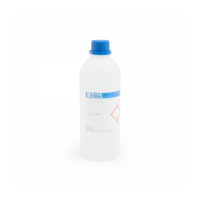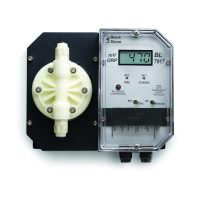| Parameter |
Range |
Resolution |
Accuracy |
| Alkalinity |
0 to 500 mg/L (as CaCO₃) |
1 mg/L |
±5 mg/L ±5% of reading at 25 °C |
| Alkalinity, Marine |
0 to 300 mg/L (as CaCO₃) |
1 mg/L |
±5 mg/L ±5% of reading at 25 °C |
| Aluminum |
0.00 to 1.00 mg/L (as Al³+) |
0.01 mg/L |
±0.04 mg/L ±4% of reading at 25 °C |
| Ammonia Low Range |
0.00 to 3.00 mg/L (as NH₃-N) |
0.01 mg/L |
±0.04 mg/L ±4% of reading at 25 °C |
| Ammonia Low Range (13 mm Vial) |
0.00 to 3.00 mg/L (as NH₃-N) |
0.01 mg/L |
±0.10 mg/L or ± 5% of reading at 25 °C,
whichever is greater |
| Ammonia Low Range ISO (13 mm Vial) |
0.000 to 2.500 mg/L (as NH₄+) |
0.001 mg/L |
±0.015 mg/L ± 3% of reading at 25 °C |
| Ammonia Medium Range |
0.00 to 10.00 mg/L (as NH₃-N) |
0.01 mg/L |
±0.05 mg/L ± 5% of reading at 25 °C,
whichever is greater |
| Ammonia High Range |
0.0 to 100.0 mg/L (as NH₄+) |
0.1 mg/L |
±0.5 mg/L ± 5% of reading at 25 °C |
Ammonia High Range
(13 mm Vial) |
0.0 to 100.0 mg/L (as NH₃-N) |
0.1 mg/L |
±1.0 mg/L or ± 5% of reading at 25 °C,
whichever is greater |
| Bromine |
0.00 to 10.00 mg/L (as Br₂) |
0.01 mg/L |
±0.08 mg/L ±3% of reading at 25 °C |
| Calcium |
0 to 400 mg/L (as Ca²+) |
1 mg/L |
±10 mg/L ±5% of reading at 25 °C |
| Calcium, Marine |
200 to 600 mg/L (as Ca²+) |
1 mg/L |
± 5% of reading at 25 °C |
| Chloride |
0.0 to 20.0 mg/L (as Cl–) |
0.1 mg/L |
±0.5 mg/L ±5% of reading at 25 °C |
| Chlorine Dioxide |
0.00 to 2.00 mg/L (as ClO₂) |
0.01 mg/L |
±0.10 mg/L ±5% of reading at 25 °C |
| Chlorine Dioxide (Rapid) |
0.00 to 2.00 mg/L (as ClO₂) |
0.01 mg/L |
±0.10 mg/L ±5% of reading at 25 °C |
Chlorine, Free
Ultra Low Range |
0.000 to 0.500 mg/L (as Cl₂) |
0.001 mg/L |
±0.020 mg/L ±3% of reading at 25 °C |
| Chlorine, Free Low Range (Powder Reagent) |
0.00 to 5.00 mg/L (as Cl₂) |
0.01 mg/L |
±0.03 mg/L ±3% of reading at 25 °C |
| Chlorine, Free Low Range (Liquid Reagent) |
0.00 to 5.00 mg/L (as Cl₂) |
0.01 mg/L |
±0.03 mg/L ±3% of reading at 25 °C |
| Chlorine, Free High Range |
0.00 to 10.00 mg/L (as Cl₂) |
0.01 mg/L |
±0.03 mg/L ±3% of reading at 25 °C |
Chlorine, Total
Ultra Low Range |
0.000 to 0.500 mg/L (as Cl₂) |
0.001 mg/L |
±0.020 mg/L ±3% of reading at 25 °C |
| Chlorine, Total Low Range (Powder Reagent) |
0.00 to 5.00 mg/L (as Cl₂) |
0.01 mg/L |
±0.03 mg/L ±3% of reading at 25 °C |
| Chlorine, Total Low Range (Liquid Reagent) |
0.00 to 5.00 mg/L (as Cl₂) |
0.01 mg/L |
±0.03 mg/L ±3% of reading at 25 °C |
| Chlorine, Total High Range |
0.00 to 10.00 mg/L (as Cl₂) |
0.01 mg/L |
±0.03 mg/L ±3% of reading at 25 °C |
| Chlorine, Total Ultra High Range |
0 to 500 mg/L (as Cl₂) |
1 mg/L |
±3 mg/L ±3% of reading at 25 °C |
| Chromium (VI) Low Range |
0 to 300 μg/L (as Cr(VI)) |
1 μg/L |
±10 μg/L ±4% of reading at 25 °C |
| Chromium (VI) High Range |
0 to 1000 μg/L (as Cr(VI)) |
1 μg/L |
±5 μg/L ±4% of reading at 25 °C |
Chromium (VI)/Total
(13 mm Vial) |
0 to 1000 μg/L (as Cr) |
1 μg/L |
±10 μg/L ± 3% of reading |
| Chemical Oxygen Demand Low Range EPA (13 mm Vial) |
0 to 150 mg/L (as O₂) |
1 mg/L |
±5 mg/L or ±4% of reading at 25 °C, whichever is greater |
| Chemical Oxygen Demand Low Range Mercury Free (13 mm Vial) |
0 to 150 mg/L (as O₂) |
1 mg/L |
±5 mg/L or ±4% of reading at 25 °C,
whichever is greater |
| Chemical Oxygen Demand Low Range ISO (13 mm Vial) |
0 to 150 mg/L (as O₂) |
1 mg/L |
±5 mg/L or ±4% of reading at 25 °C, whichever is greater |
| Chemical Oxygen Demand Medium Range EPA (13 mm Vial) |
0 to 1500 mg/L (as O₂) |
1 mg/L |
±15 mg/L or ±3% of reading at 25 °C,
whichever is greater |
| Chemical Oxygen Demand Medium Range Mercury Free (13 mm Vial) |
0 to 1500 mg/L (as O₂) |
1 mg/L |
±15 mg/L or ±3% of reading at 25 °C,
whichever is greater |
| Chemical Oxygen Demand Medium Range ISO (13 mm Vial) |
0 to 1000 mg/L (as O₂) |
1 mg/L |
±15 mg/L or ±3% of reading at 25 °C,
whichever is greater |
| Chemical Oxygen Demand High Range EPA (13 mm Vial) |
0 to 15000 mg/L (as O₂) |
1 mg/L |
±150 mg/L or ±2% of reading at 25 °C,
whichever is greater |
| Chemical Oxygen Demand Ultra High Range (13 mm Vial) |
0.0 to 60.0 ppt (as O₂) |
0.1 ppt |
±0.5 ppt ±3% of reading @ 25°C |
| Color ADMI Low Range |
0 to 250 ADMI Pt-Co |
1 ADMI Pt-Co |
±5 ADMI Pt-Co at 25 °C |
| Color ADMI High Range |
0 to 600 ADMI Pt-Co |
1 ADMI Pt-Co |
±20 ADMI Pt-Co at 25 °C |
| Color of Water |
0 to 500 PCU (Platinum Cobalt Units) |
1 PCU |
±10 PCU ±5% of reading at 25 °C |
| Copper Low Range |
0 to 1500 μg/L (as Cu) |
1 μg/L |
±10 μg/L ±5% of reading at 25 °C |
| Copper High Range |
0.00 to 5.00 mg/L (as Cu) |
0.01 mg/L |
±0.02 mg/L ±4% of reading at 25 °C |
| Cyanide |
0.000 to 0.200 mg/L (as CN–) |
0.001 mg/L |
±0.005 mg/L ±3% of reading at 25 °C |
| Cyanuric Acid |
0 to100 mg/L (as CYA) |
1 mg/L |
±1 mg/L ±15% of reading at 25 °C |
| Fluoride Low Range |
0.00 to 2.00 mg/L (as F–) |
0.01 mg/L |
±0.03 mg/L ±3% of reading at 25 °C |
| Fluoride High Range |
0.0 to 20.0 mg/L (as F–) |
0.1 mg/L |
±0.5 mg/L ±3% of reading at 25 °C |
| Hardness, Calcium |
0.00 to 2.70 mg/L (as CaCO₃) |
0.01 mg/L |
±0.08 mg/L ±4% of reading at 25 °C |
| Hardness, Magnesium |
0.00 to 2.00 mg/L (as CaCO₃) |
0.01 mg/L |
±0.11 mg/L ±5% of reading at 25 °C |
| Hardness, Total Low Range |
0 to 250 mg/L (as CaCO₃) |
1 mg/L |
±5 mg/L ±4% of reading at 25 °C |
| Hardness, Total Medium Range |
200 to 500 mg/L (as CaCO₃) |
1 mg/L |
±7 mg/L ±3% of reading at 25 °C |
| Hardness, Total High Range |
400 to 750 mg/L (as CaCO₃) |
1 mg/L |
±10 mg/L ±2% of reading at 25 °C |
| Hydrazine |
0 to 400 μg/L (as N₂H₄) |
1 μg/L |
±3 μg/L ±3 % of reading at 25°C |
| Iodine |
0.0 to 12.5 mg/L (as I₂) |
0.1 mg/L |
±0.1 mg/L ±5% of reading at 25 °C |
| Iron Low Range |
0.000 to 1.600 mg/L (as Fe) |
0.001 mg/L |
±0.010 mg/L ±8% of reading at 25 °C |
| Iron High Range |
0.00 to 5.00 mg/L (as Fe) |
0.01 mg/L |
±0.04 mg/L ±2% of reading at 25 °C |
| Iron (II) (Ferrous) |
0.00 to 6.00 mg/L (as Fe²+) |
0.01 mg/L |
±0.10 mg/L ±2% of reading at 25 °C |
| Iron (13 mm Vial) |
0.00 to 6.00 mg/L (as Fe) |
0.01 mg/L |
±0.10 mg/L or ±3% of reading at 25°C |
| Iron Total (13 mm Vial) |
0.00 to 7.00 mg/L (as Fe) |
0.01 mg/L |
±0.20 mg/L or± 3% of reading, whichever is greater |
| Magnesium |
0 to 150 mg/L (as Mg²+) |
1 mg/L |
±5 mg/L ±3% of reading at 25 °C |
| Magnesium, Marine |
1000 to 1800 mg/L (as Mg²+) |
5 mg/L |
±5% of reading |
| Manganese Low Range |
0 to 300 μg/L (as Mn) |
1 μg/L |
±7 μg/L ±3% of reading at 25 °C |
| Manganese High Range |
0.0 to 20.0 mg/L (as Mn) |
0.1 mg/L |
±0.2 mg/L ±3% of reading at 25 °C |
| Maple Syrup |
0.00 to 100.00 %T |
0.01 %T |
±3% of reading at 25 °C |
| Molybdenum |
0.0 to 40.0 mg/L (as Mo⁶+) |
0.1 mg/L |
±0.3 mg/L ±5% of reading at 25 °C |
| Nickel Low Range |
0.000 to 1.000 mg/L (as Ni) |
0.001 mg/L |
±0.010 mg/L ±7% of reading at 25 °C |
| Nickel High Range |
0.00 to 7.00 ppt (as Ni) |
0.01 ppt |
±0.07 ppt±4% of reading at 25 °C |
| Nitrate |
0.0 to 30.0 mg/L (as NO₃¯-N) |
0.1 mg/L |
±0.5 mg/L ±10% of reading at 25 °C |
| Nitrate Chromotropic Acid (13 mm Vial) |
0.0 to 30.0 mg/L (as N0₃¯-N) |
0.1 mg/L |
±1.0 mg/L or ±3% of reading at 25 °C,
whichever is greater |
| Nitrate, Marine High Range |
0.0 to 75.0 mg/L (as N0₃) |
0.1 mg/L |
±2.0 mg/L ± 5 % of reading |
| Nitrite Low Range |
0 to 600 μg/L (as NO₂¯-N) |
1 μg/L |
±20 μg/L ±4% of reading at 25 °C |
| Nitrite Low Range (13 mm Vial) |
0 to 600 μg/L (as NO₂¯-N) |
1 μg/L |
±10 μg/L ± 3% of reading at 25°C, whichever is greater |
| Nitrite Medium Range (13 mm Vial) |
0.00 to 6.00 mg/L (as NO₂¯-N) |
0.01 mg/L |
±0.10 mg/L ± 3% of reading at 25°C |
| Nitrite High Range |
0 to 150 mg/L (as NO₂¯) |
1 mg/L |
±4 mg/L ±4% of reading at 25 °C |
| Nitrite, Marine Ultra Low Range |
0 to 200 μg/L (as N0₂¯-N) |
1 μg/L |
±8 μg/L ±4% of reading at 25 °C |
| Nitrite, Seawater (13 mm Vial) |
0 to 600 μg/L (as N0₂¯-N) |
1 μg/L |
±15 μg/L ±5% of reading at 25 °C |
| Nitrogen, Total Low Range (13 mm Vial) |
0.0 to 25.0 mg/L (as N) |
0.1 mg/L |
±1.0 mg/L or ±5% of reading at 25 °C,
whichever is greater |
| Nitrogen, Total High Range (13 mm Vial) |
10 to 150 mg/L (as N) |
1 mg/L |
±3 mg/L or ±4% of reading at 25 °C,
whichever is greater |
| Oxygen, Dissolved |
0.0 to 10.0 mg/L (as O₂) |
0.1 mg/L |
±0.4 mg/L ±3% of reading at 25 °C |
| Oxygen Scavengers (Carbohydrazide) |
0.00 to 1.50 mg/L
(as Carbohydrazide) |
0.01 mg/L |
±0.02 mg/L ±3% of reading at 25 °C |
| Oxygen Scavengers (Diethylhydroxylamine) (DEHA) |
0 to 1000 μg/L (as DEHA) |
1 μg/L |
±5 μg/L ±5% of reading at 25 °C |
| Oxygen Scavengers (Hydroquinone) |
0.00 to 2.50 mg/L (as Hydroquinone) |
0.01 mg/L |
±0.04 mg/L ±3% of reading at 25 °C |
| Oxygen Scavengers (Isoascorbic Acid) |
0.00 to 4.50 mg/L
(as Iso-Ascorbic Acid) |
0.01 mg/L |
±0.03 mg/L ±3 % of reading at 25 °C |
| Ozone |
0.00 to 2.00 mg/L (as O₃) |
0.01 mg/L |
±0.02 mg/L ±3% of reading at 25 °C |
| pH |
6.5 to 8.5 pH |
0.1 pH |
±0.1 pH at 25 °C |
Phenols
(13 mm Vial) |
0.00 to 5.00 mg/L |
0.01 mg/L |
±0.05 mg/L ±3 % of reading at 25 °C |
| Phosphate Low Range |
0.00 to 2.50 mg/L (as PO₄³¯) |
0.01 mg/L |
±0.04 mg/L ±4% of reading at 25 °C |
| Phosphate High Range |
0.0 to 30.0 mg/L (as PO₄³¯) |
0.1 mg/L |
±1.0 mg/L ±4% of reading at 25 °C |
| Phosphorus, Acid Hydrolyzable (13 mm Vial) |
0.00 to 1.60 mg/L (as P) |
0.01 mg/L |
±0.05 mg/L or ±5% of reading at 25 °C,
whichever is greater |
| Phosphorus, Reactive Low Range (13 mm Vial) |
0.00 to 1.60 mg/L (as P) |
0.01 mg/L |
±0.05 mg/L or ±4% of reading at 25 °C,
whichever is greater |
| Phosphorus, Reactive High Range (13 mm Vial) |
0.0 to 32.6 mg/L (as P) |
0.1 mg/L |
±0.5 mg/L or ±4% of reading at 25 °C,
whichever is greater |
| Phosphorus, Total Low Range (13 mm Vial) |
0.00 to 1.60 mg/L (as P) |
0.01 mg/L |
±0.05 mg/L or ±5% of reading at 25 °C,
whichever is greater |
| Phosphorus, Total High Range (13 mm Vial) |
0.0 to 32.6 mg/L (as P) |
0.1 mg/L |
±0.5 mg/L or ±5% of reading at 25 °C,
whichever is greater |
| Phosphorus, Marine Ultra Low Range |
0 to 200 μg/L (as P) |
1 μg/L |
±5 μg/L ±5% of reading at 25 °C |
| Potassium Low Range |
0.0 to 20.0 mg/L (as K) |
0.1 mg/L |
±2 mg/L ±7% of reading at 25 °C |
| Potassium Medium Range |
10 to 100 mg/L (as K) |
1 mg/L |
±10 mg/L ±7% of reading at 25 °C |
| Potassium High Range |
20 to 200 mg/L (as K) |
1 mg/L |
±20 mg/L ±7% of reading at 25 °C |
| Silica Low Range |
0.00 to 2.00 mg/L (as SiO₂) |
0.01 mg/L |
±0.03 mg/L ±5% of reading at 25 °C |
| Silica High Range |
0 to 200 mg/L (as SiO₂) |
1 mg/L |
±1 mg/L ±5% of reading at 25 °C |
| Silver |
0.000 to 1.000 mg/L (as Ag) |
0.001 mg/L |
±0.020 mg/L ±5% of reading at 25 °C |
| Sulfate |
0 to 150 mg/L (as SO₄²¯) |
1 mg/L |
±5 mg/L ±3% of reading at 25 °C |
| Surfactants, Anionic |
0.00 to 3.50 mg/L (as SDBS) |
0.01 mg/L |
±0.04 mg/L ±3% of reading at 25 °C |
| Surfactants, Anionic (13 mm Vial) |
0.00 to 3.50 mg/L (as SDBS) |
0.01 mg/L |
±0.10 mg/L ±5% of reading at 25 °C |
| Surfactants, Cationic (13 mm Vial) |
0.00 to 2.50 mg/L (as CTAB) |
0.01 mg/L |
±0.15 ppm ±3% of reading at 25°C |
| Surfactants, Nonionic (13 mm Vial) |
0.00 to 6.00 mg/L (TRITON X-100) |
0.01 mg/L |
±0.10 mg/L ±5% of reading at 25 °C |
| Zinc |
0.00 to 3.00 mg/L (as Zn) |
0.01 mg/L |
±0.03 mg/L ±3% of reading at 25 °C |
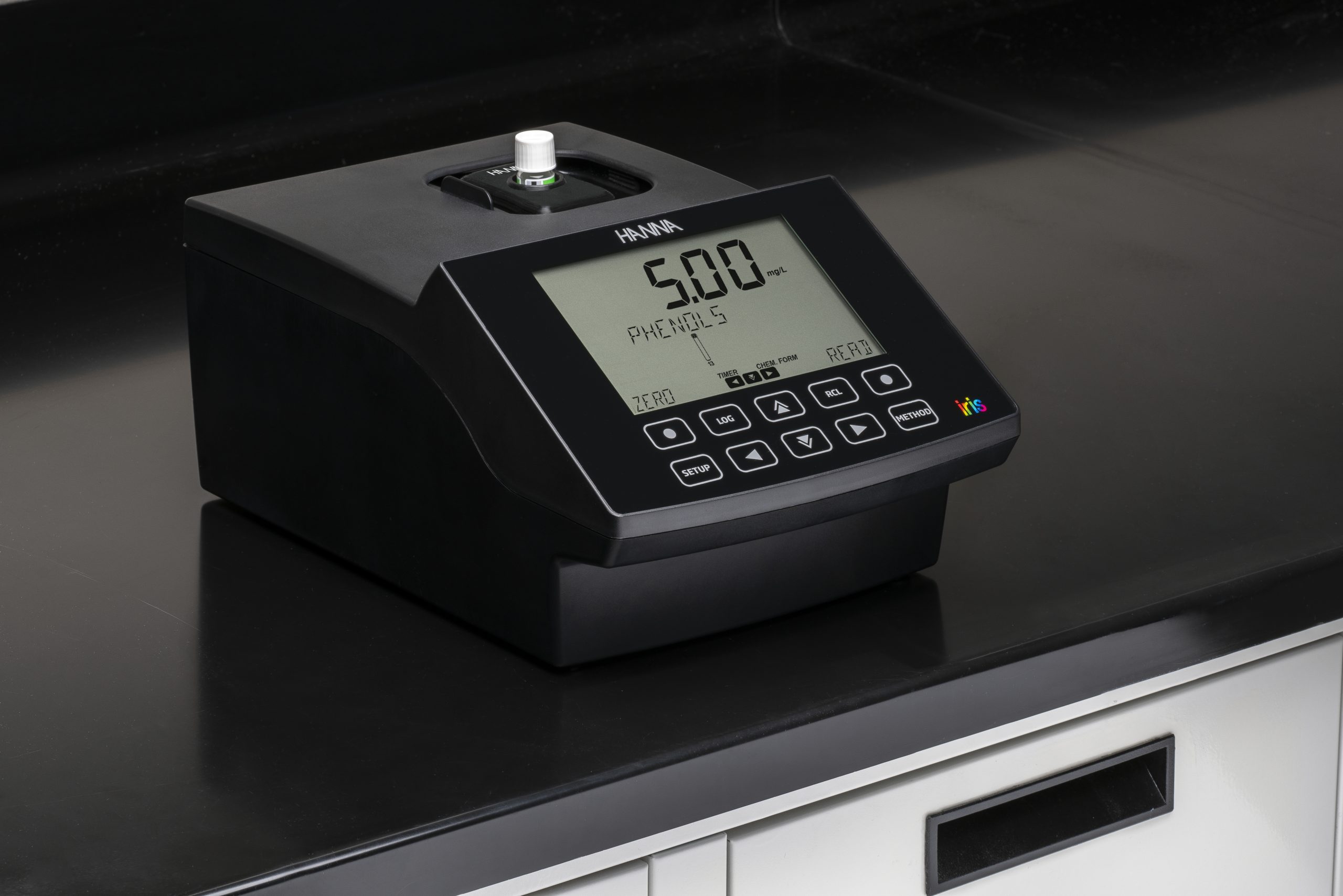
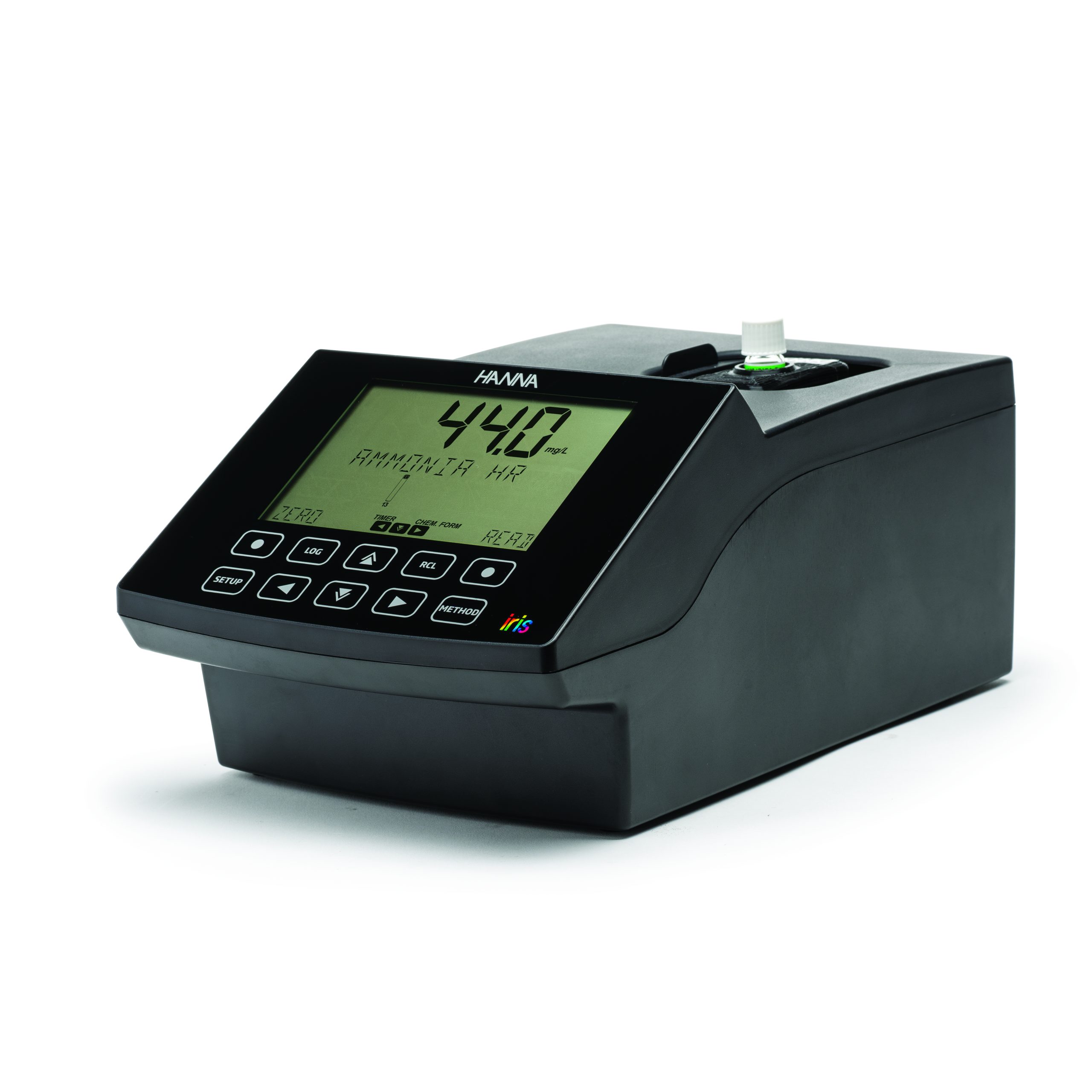
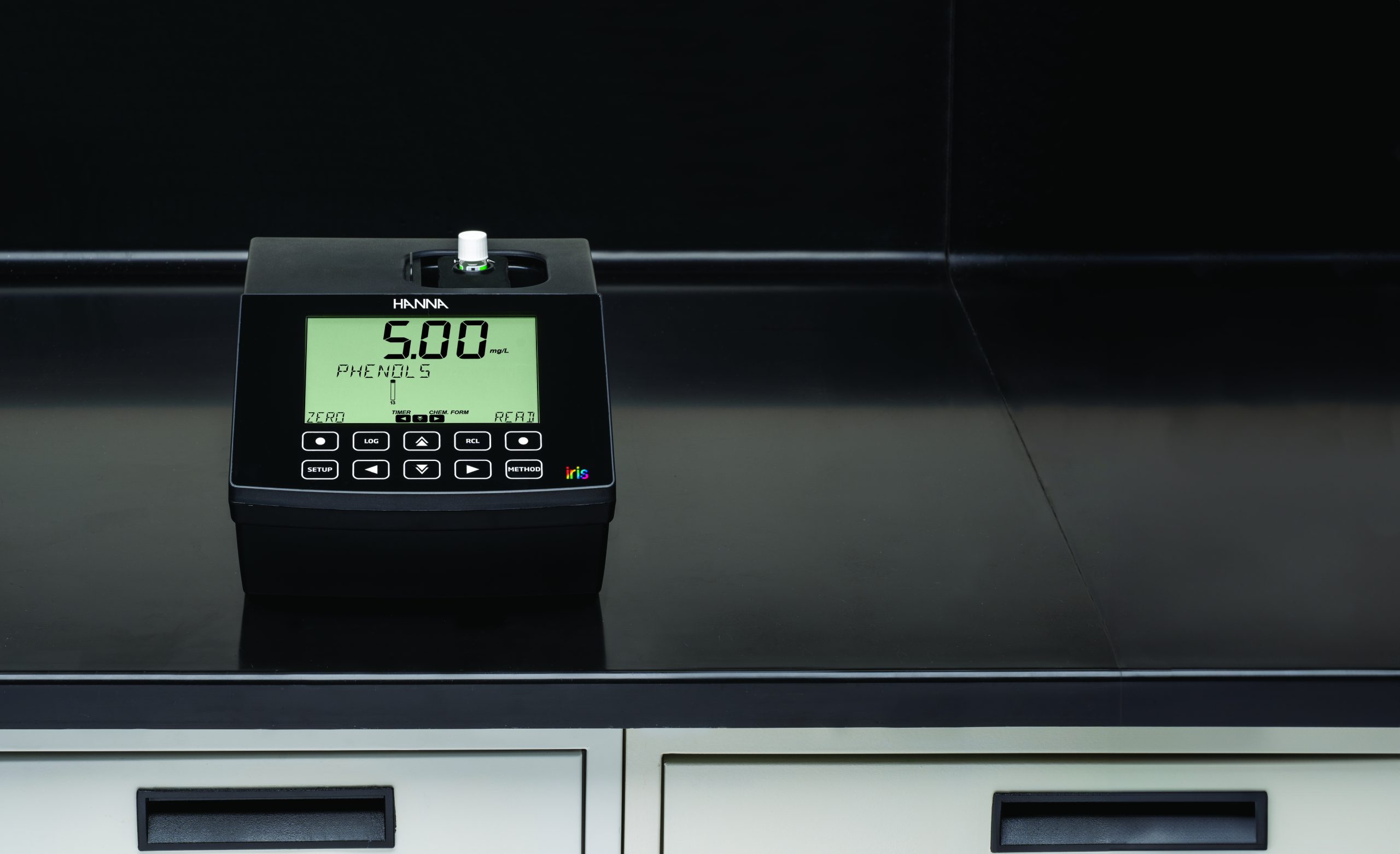
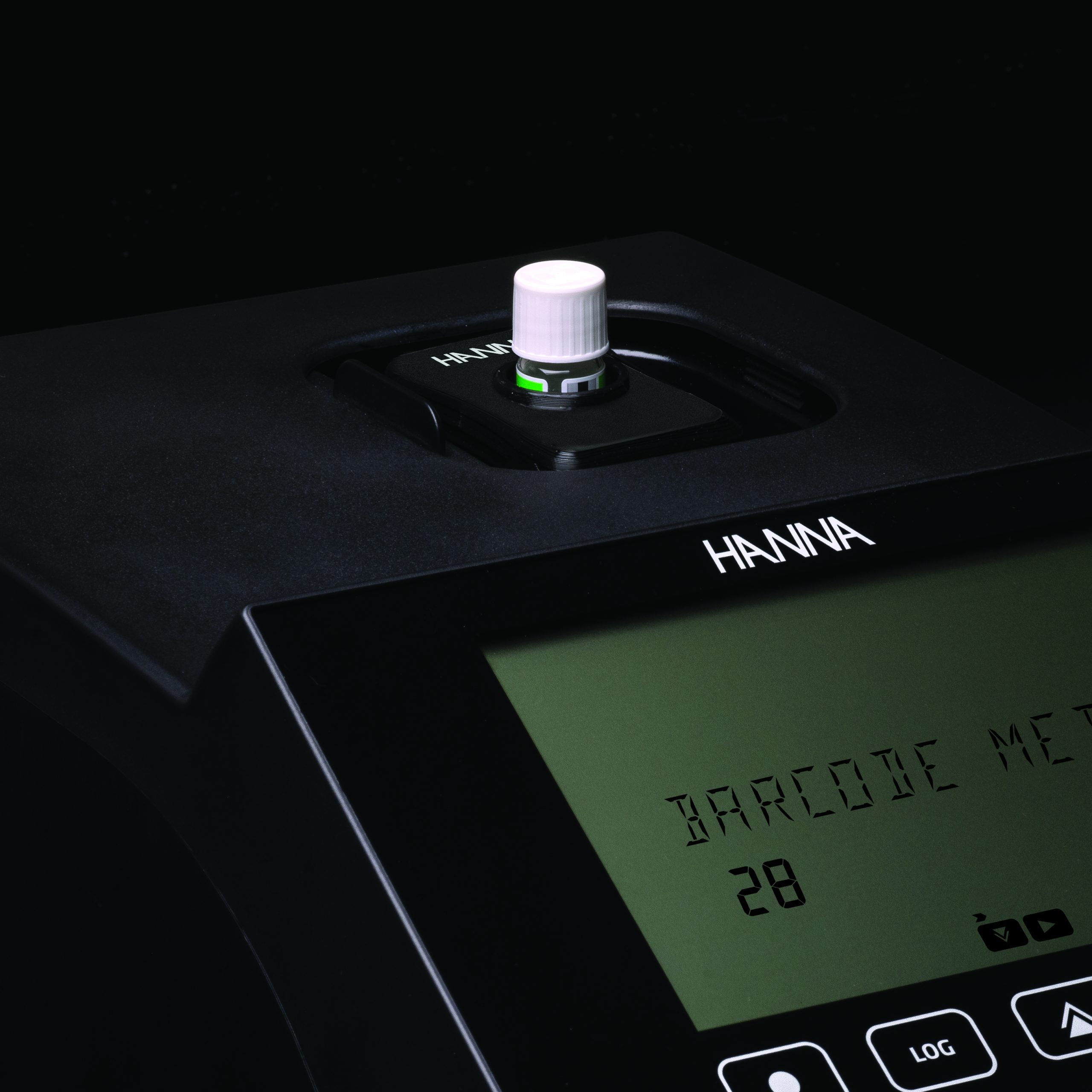
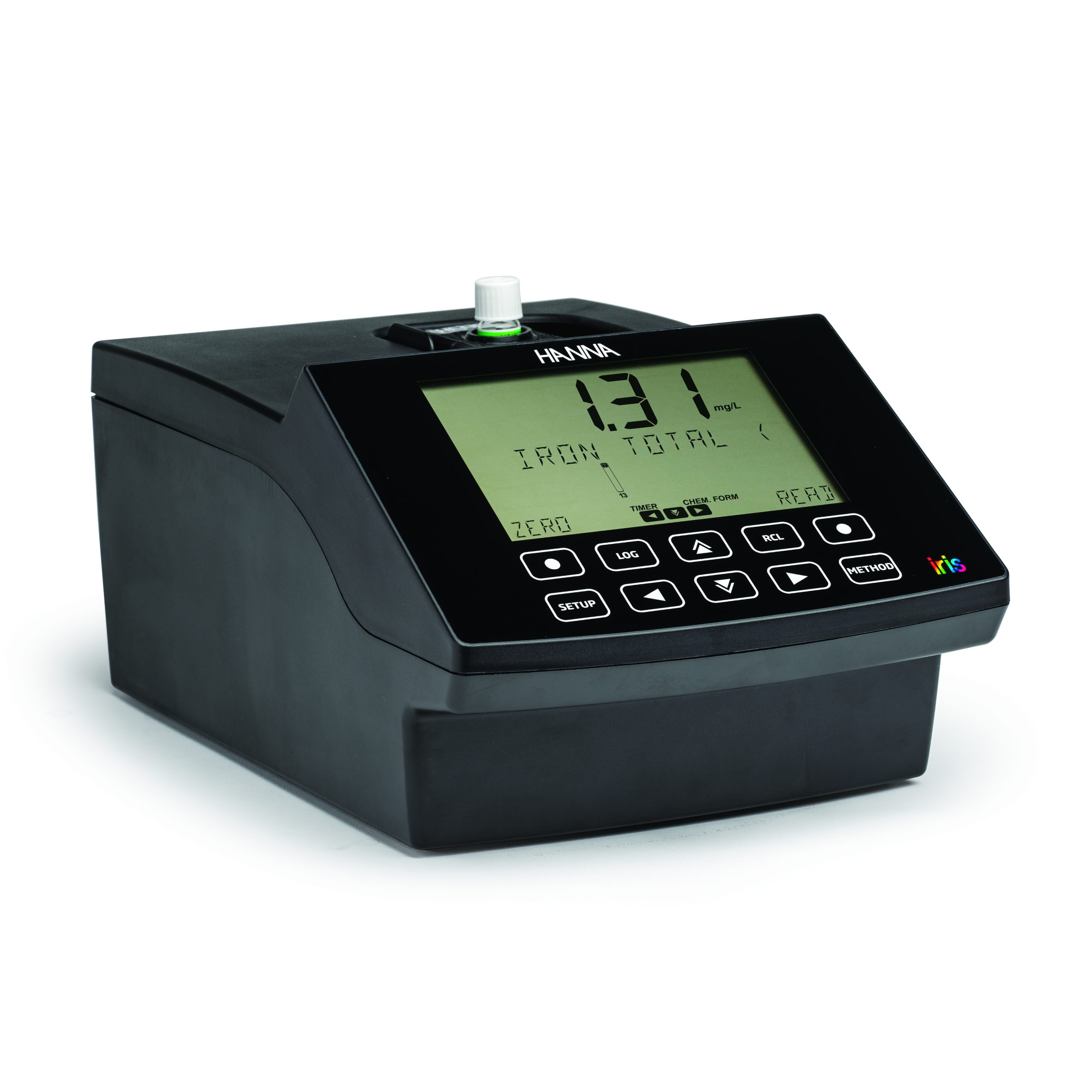
 HI802 iris® visible spectrophotometer quickly identifies Hanna Instruments vial methods by reading the barcode on reagent vials across multiple methods that support the use of a single-zero measurement.
HI802 iris® visible spectrophotometer quickly identifies Hanna Instruments vial methods by reading the barcode on reagent vials across multiple methods that support the use of a single-zero measurement.
